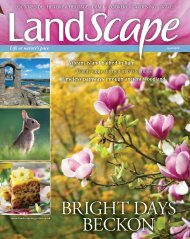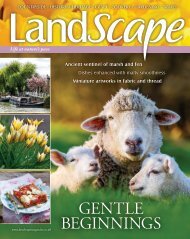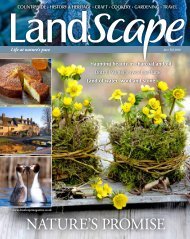You also want an ePaper? Increase the reach of your titles
YUMPU automatically turns print PDFs into web optimized ePapers that Google loves.
FREE SEEDS<br />
WORTH<br />
£2.99<br />
<strong>March</strong> 2018 £4.10<br />
540<br />
Plug plants<br />
for £36 *<br />
*Just pay postage<br />
Seasonal<br />
making beautiful gardens<br />
Create some<br />
sparkle<br />
Treat yourself to the<br />
earliest bulbs and<br />
shrubs for fragrance<br />
Beautiful gardens<br />
✿ Woodland flowers light up an English idyll<br />
✿ Historic folly, beebole & dovecote add grandeur<br />
✿ Elegant garden has picture-perfect pond<br />
Make a<br />
colour<br />
statement<br />
Top ten annuals to boost<br />
your flower power<br />
Meet the real<br />
stars of spring<br />
Learn the secrets of frost<br />
proof magnolias<br />
discover...<br />
how to...<br />
GROW GOURMET ROOTS<br />
Exciting new cultivars to try<br />
Easy<br />
step by<br />
step<br />
Fold your own pots<br />
No tape or staples required!<br />
HELP our BUTTERFLIES<br />
Easy catering for caterpillars<br />
OCTOBER MARCH ISSUE ISSUE 31 JANUARY-27 13 Sept - 10 Oct FEBRUARY
es<br />
58<br />
reader<br />
garden<br />
64<br />
visit<br />
Hidcote<br />
70<br />
garden<br />
wildlife<br />
38<br />
paper<br />
pots<br />
Beautiful gardens<br />
46<br />
cover<br />
STORY<br />
52<br />
cover<br />
STORY<br />
58<br />
cover<br />
STORY<br />
64<br />
WILDlife<br />
70<br />
cover<br />
STORY<br />
“It’s full of lovely views”<br />
Naturalised bulbs and woodland<br />
flowers transform this English<br />
garden in <strong>March</strong><br />
“The garden stirs into life in<br />
spring” With its folly, beebole and<br />
dovecote, this historic plot is full of<br />
drama and flowers<br />
“Our garden is so picturesque”<br />
This elegant garden with spring<br />
bulbs and pretty pond looks<br />
perfect from every angle<br />
<strong>Garden</strong> to visit Hidcote is famous<br />
for its yew-framed garden rooms<br />
and exuberant planting schemes<br />
Plant for your butterflies...<br />
but we can’t enjoy these winged<br />
wonders without catering for their<br />
caterpillars too. Here’s how<br />
Gourmet grower<br />
75<br />
cover<br />
STORY<br />
ask the experts<br />
81<br />
90<br />
92<br />
GARDEN BUYS<br />
44<br />
96<br />
Grow gourmet roots Root crops<br />
come in all shapes, sizes and<br />
colours. Here’s how to grow them<br />
Ask <strong>Garden</strong> <strong>Answers</strong> Our expert<br />
Geoff Stebbings provides answers<br />
to your gardening questions<br />
Border rescue Bare soil in <strong>March</strong><br />
presents an opportunity to plant<br />
evergreens and spring flowers<br />
Design solutions Gear up the<br />
garden for entertaining outdoors<br />
Subscribe to <strong>Garden</strong> <strong>Answers</strong><br />
Pay just £2.62 per issue!<br />
Buyers’ Guide to growing frames<br />
Broaden your gardening horizons<br />
102<br />
104<br />
106<br />
your garden life<br />
100<br />
109<br />
114<br />
Save £5 on Nandina ‘Fire Power’<br />
and offers on pots and daphne<br />
plants from You<strong>Garden</strong><br />
540 extra-value plug plants for<br />
£36 *plus p&p! Fill summer beds<br />
and pots with this Suttons offer<br />
200 summer-flowering bulbs for<br />
£17.99 – a great-value offer for<br />
seasonal colour from Dobies<br />
Over to you Readers share their<br />
gardening stories to win an RSPB<br />
feeding station. Plus, send us your<br />
photos to win Felco secateurs<br />
Puzzles and prizes This month you<br />
can win a flower card game from<br />
Laurence King, or Hayloft vouchers<br />
worth £50, with a 10% discount<br />
<strong>Garden</strong> view Helen Billiald’s<br />
greenhouse is her refuge… find out<br />
why she loves to escape there<br />
Subscribe at www.greatmagazines.co.uk 5
SUBSCRIBE<br />
today<br />
And pay just £2.62 per<br />
issue – see page 44<br />
75<br />
tasty<br />
tomatoes<br />
540<br />
plugs<br />
for £36*<br />
Fill beds and pots<br />
with our offer<br />
on p104<br />
14<br />
signs of<br />
spring<br />
90<br />
border<br />
rescue<br />
Cover: gap photos/Dave Zubraski<br />
Magnificent<br />
magnolias, p26<br />
On the cover<br />
14 Create seasonal sparkle<br />
22 Make a colour statement<br />
26 The real stars of spring<br />
38 Fold your own pots<br />
46 Woodland flowers...<br />
52 Historic folly...<br />
58 Elegant garden...<br />
70 Help our butterflies<br />
75 Grow gourmet roots<br />
104 540 plug plants for £36 plus p&p<br />
Contents<br />
Celebrate<br />
28<br />
Celebrate apple blossom A tunnel<br />
6<br />
of espaliered apple trees is both<br />
pretty and productive<br />
8<br />
Be inspired by… Ferns unfurling,<br />
novelty gnomes, flowers for <strong>March</strong>,<br />
14<br />
little blue bulbs and our bud-ID quiz<br />
Discover the first signs of spring<br />
As the garden begins to stir, there<br />
are plenty of sensory treats to lure<br />
you outdoors<br />
33<br />
Make a colour statement Annuals<br />
22<br />
are a cheap and easy source of<br />
38<br />
glorious summer colour<br />
26<br />
Enjoy the real stars of spring<br />
Showy and fragrant, some<br />
magnolias are surprisingly<br />
40<br />
frost-resistant. Here’s our pick<br />
of the best garden cultivars<br />
cover<br />
STORY<br />
cover<br />
STORY<br />
cover<br />
STORY<br />
cover<br />
STORY<br />
Give bedding a new twist<br />
Take planting inspiration from<br />
the sweet shop and dessert trolley<br />
to inject fresh colour into annual<br />
planting schemes<br />
Easy gardening<br />
cover<br />
STORY<br />
cover<br />
STORY<br />
What to do this month Grow<br />
annual climbers, tidy up spring<br />
bulbs and order plug plants. Plus<br />
there’s still time to move evergreens<br />
Make your own paper pots These<br />
eco-friendly, biodegradable<br />
containers are great for sowing<br />
seed and won’t cost a penny<br />
Plant a spring sensation Perennial<br />
wallflowers, tiarellas and primulas<br />
light up the <strong>March</strong> garden, jostling<br />
beneath a red-stemmed cornus<br />
4 <strong>Garden</strong> <strong>Answers</strong>
Plant a spring<br />
sensation<br />
Perennial wallflowers, tiarellas and primulas light up the<br />
<strong>March</strong> garden, jostling beneath a red-stemmed cornus<br />
Sometimes we’re happily planning and planting our<br />
gardens six months ahead, at other times it’s a struggle<br />
to plan for the following weekend... The wonderful thing<br />
about this border is that you can start it now and enjoy a display<br />
this spring as well as in the years to come.<br />
This pretty combination is essentially a woodland scheme<br />
using plants that like a humus-rich, moisture-retentive soil.<br />
The white spires of tiarella lift the whole picture, while the<br />
unusual scented perennial wallflower ‘Winter Orchid’ echoes<br />
the warmth of the red-stemmed dogwood.<br />
STEP 2<br />
Choose the right plants<br />
STEP 1<br />
Design your<br />
border<br />
Cornus alba<br />
‘Sibirica’<br />
3easy<br />
steps<br />
Tiarella<br />
‘Spring Symphony’<br />
Cornus alba ‘Sibirica’<br />
This red-stemmed dogwood<br />
lights up the winter garden<br />
and has colourful autumn<br />
foliage too. Cut back in spring<br />
to boost the stem colour.<br />
H and S up to 2.5m (8ft)<br />
Tiarella ‘Spring<br />
Symphony’ Pink buds open to<br />
starry white spires April-June.<br />
This perennial lives up to its<br />
name of ‘foam flower’. Leaves<br />
have attractive dark centres.<br />
H and S30cm (12in)<br />
Words: HELEN BILLIALD photos: Gap Photos/Friedrich Strauss; alamy; shutterstock Illustration: Gill Lockhart<br />
Primula<br />
‘Dawn Ansell’<br />
Primula<br />
‘Belarina Rosette<br />
Nectarine’<br />
Erysimum<br />
‘Winter Orchid’<br />
Pulmonaria<br />
‘Blue Ensign’<br />
Erysimum ‘Winter Orchid’<br />
These fragrant, coppery,<br />
burnt-orange flowers fade to<br />
purple, from <strong>March</strong> to late<br />
summer. Perennial in a<br />
well-drained, sheltered spot.<br />
H30cm (12in) S40cm (16in)<br />
Primula ‘Dawn Ansell’<br />
An elegant and robust plant<br />
that blooms late winter to<br />
spring. Its double white<br />
flowers have a green ruff<br />
and feature a hint of green<br />
at the eye. H and S15cm (6in)<br />
Primula ‘Belarina<br />
rosette Nectarine’<br />
Yellow buds open to warm<br />
orange, two-toned double<br />
flowers tipped with pinky-red.<br />
Flowers spring to summer.<br />
H15cm (6in) S30cm (12in)<br />
Pulmonaria ‘Blue Ensign’<br />
Violet-blue flowers that fade<br />
to purple, from <strong>March</strong> to May.<br />
Loved by pollinators and<br />
supported by a neat rosette of<br />
dark green leaves. H30cm<br />
(12in) S45cm (18in)<br />
➤<br />
Subscribe at www.greatmagazines.co.uk 41
Easy gardening<br />
STEP 3<br />
Plant your border<br />
This combination consists of mostly<br />
woodland plants that like a humus-rich,<br />
moist but well-drained soil in part shade.<br />
Give them a weed-free start and add<br />
plenty of well-rotted garden compost<br />
or leafmould to the soil, plus extra<br />
grit if you’re on heavy clay to improve<br />
drainage. Give the entire planting a<br />
generous annual mulch of well-rotted<br />
organic matter to retain moisture and<br />
gradually improve soil structure.<br />
1<br />
Plant the dogwood<br />
Look out for bareroot cornus plants<br />
from November to April, or pick up<br />
container-grown specimens at other times<br />
of the year. Make sure you soak bareroot<br />
plants thoroughly in a bucket of water for<br />
an hour before planting. To help imagine<br />
the shrub’s eventual spread, use a tape<br />
measure to be sure you’re not crowding it<br />
between other plants. Firm and water<br />
deeply after planting, then finish with a<br />
mulch of well-rotted organic matter.<br />
Once ‘Sibirica’ is established (after two<br />
or three years), coppice plants hard in early<br />
spring, back to a low framework of shoots.<br />
This encourages young stems that carry<br />
the most dramatic red colour. Or prune out<br />
a third of the stems annually for a more<br />
gradual renewal and year-round structure.<br />
2<br />
Underplant with tiarella<br />
The tiarella is the star of this<br />
planting, and you’ll get the biggest impact<br />
from a generous sweep of plants. However,<br />
if you’re on a budget, they’ll happily spread<br />
so you can slowly increase their numbers in<br />
time. They thrive in semi-shade with<br />
humus-rich soil around their feet – think<br />
moisture-retentive but not waterlogged.<br />
Plant and divide established clumps in<br />
Make the display last...<br />
spring just as they<br />
start into growth.<br />
Keep them looking<br />
tidy by clearing<br />
away old leaves in<br />
spring and later by<br />
deadheading after<br />
flowering.<br />
3<br />
Add the<br />
primulas<br />
Tough and reliable<br />
primulas return year<br />
after year, then flower<br />
their socks off. Plant<br />
them in September/<br />
October or look out for<br />
young plants in garden<br />
centres in spring. They do<br />
best in part shade and will need<br />
dividing every couple of years,<br />
either straight after flowering in May<br />
(if your garden is exposed) or in early<br />
autumn. A loose covering of dry mulch<br />
such as straw will help protect earlyflowering<br />
plants during a sudden cold snap.<br />
4<br />
Trickle through<br />
the wallflowers<br />
...or try<br />
this<br />
‘Winter Orchid’ is a rather unusual scented<br />
perennial wallflower. Give it well-drained<br />
soil and a protected site or it tends to be<br />
short lived. Look out for this cultivar in<br />
autumn or spring (<strong>March</strong>/April); they’re<br />
worth tracking down because the flowers<br />
keep coming right through until August.<br />
Spring plants in particular may need extra<br />
water to stop them drying out and<br />
becoming stressed over summer.<br />
5<br />
Bluebells and purple<br />
lysimachia also make<br />
good companions<br />
for frothy tiarella<br />
Fill gaps with pulmonaria<br />
Bring some contrast to the planting<br />
with rich blue pulmonaria flowers. Plant<br />
in <strong>March</strong> or April and keep an eye on<br />
summer watering, especially during<br />
their first year. Stressed, dry plants<br />
tend to show signs of powdery mildew.<br />
You can give tired plants a<br />
tidy up after flowering by<br />
cutting them back hard,<br />
tidying away old leaves and<br />
finishing with a deep watering<br />
and thick mulch. ✿<br />
Hamamelis intermedia<br />
‘Jelena’ Witch hazel with<br />
coppery-orange flowers<br />
against bare stems January-<br />
February and rich autumn<br />
colour. H and S3m (10ft)<br />
Sarcococca confusa<br />
Sweetly scented Christmas<br />
box has glossy evergreen<br />
leaves and tiny white<br />
flowers December-<strong>March</strong>.<br />
H and S1.5m (5ft)<br />
Brunnera macrophylla<br />
‘Jack Frost’ Heart-shaped,<br />
patterned silvery leaves and<br />
delicate sprays of bright<br />
blue flowers in April-May.<br />
H40cm (16in) S60cm (2ft)<br />
<strong>Digital</strong>is purpurea<br />
Albiflora White foxglove<br />
spires are loved by bees and<br />
other beneficial insects, and<br />
appear May into summer.<br />
H1.2m (4ft) S60cm (2ft)<br />
42 <strong>Garden</strong> <strong>Answers</strong>
gourmet grower<br />
Roots to relish (clockwise from above left)<br />
yacon tubers, multicoloured carrots, horseradish,<br />
Hamburg parsley<br />
germinate and they sit quietly into the<br />
winter waiting to be used. Sow <strong>March</strong> to<br />
May and you can harvest from September<br />
onwards; they’re particularly good roasted.<br />
Salsify is one root I return to every few<br />
years because I’m keen for another hit of its<br />
delicate and appealing but rather strange<br />
flavour. Beautiful in creamy gratins it’s<br />
lovely roasted too. The roots are long and<br />
Purple kohl rabi stems<br />
partner well with<br />
feathery fennel<br />
slim (winkling them out of the<br />
ground can be tricky) and they<br />
discolour once peeled, so pop them in<br />
water and lemon juice to stop them<br />
going brown. They’re also called<br />
oyster plant but I’ve never detected<br />
that flavour; I’d put them closer to<br />
globe artichoke. Sow in spring into deep,<br />
well-drained soil and harvest from October.<br />
They keep well over winter in the ground.<br />
Coloured carrots are nothing new, but<br />
some of the variously shaded cultivars<br />
provoke fierce debate over differences<br />
in flavour. Try ‘Night Bird’ for long purpleblack<br />
roots with an intense colour that<br />
goes to the core. Or, go for an extrasweet<br />
root with yellow ‘Jaune<br />
Obtuse de Doubs’ or super-sweet<br />
off-white ‘Creampak’ F1. Sow<br />
carrots April to June into a<br />
deep, free-draining soil and<br />
cover with fleece to prevent<br />
carrot f ly.<br />
Although a swollen stem<br />
rather than a root, kohl rabi<br />
is often lumped into root<br />
veg territory. This brassica<br />
remains woefully<br />
undervalued in this<br />
country. The aim is to grow<br />
it fast in lovely rich soil and<br />
harvest when young. I grate it<br />
into coleslaw for a sweet, mild<br />
cabbage-cum-broccoli taste.<br />
Sow direct <strong>March</strong> to<br />
July and watch out<br />
for slugs and snails who love the<br />
seedlings. Try ‘Azure Star’.<br />
An overlooked root that I’m rather<br />
fond of is horseradish. A good roast<br />
seems incomplete without its pungent hit.<br />
The plants are thugs so site them carefully.<br />
They like damp ground and often seem to<br />
end up hidden at the end of a garden near the<br />
compost heap. Plant the thongs (bare roots)<br />
in <strong>March</strong> or April, potting them up first if<br />
the weather’s frightful. Harvest once the<br />
weather cools in autumn and winter.<br />
Digging up plants (as best you can) and<br />
replanting healthy roots will stop it<br />
spreading too far and keep plants youthful.<br />
Finally, for an unusual and incredibly<br />
bountiful harvest in a fertile sunny site,<br />
yacon has beautiful late summer and<br />
autumn foliage that looks perfect in a<br />
tropical border. Once frost knocks back the<br />
leaves (like a dahlia), dig up the tubers.<br />
You’ll find two types: huge baking-potatosized<br />
tubers to eat, and little knobbly<br />
growing-tip tubers, nearer the surface,<br />
which you can overwinter in a frost-free<br />
shed. I put mine in barely damp potting<br />
compost, then bring them back into growth<br />
in a greenhouse container the following<br />
spring and plant out after all risk of frost.<br />
The tubers are a sweet, crunchy delight (a<br />
cross between water chestnuts and pear)<br />
that I like to use in salads and stir-fries. ➤<br />
76 <strong>Garden</strong> <strong>Answers</strong>
Worth rooting for...<br />
Turnip ‘Tokyo Cross’<br />
Delicious, ping-pongball-sized,<br />
white roots.<br />
£1.79 for 400 seeds<br />
Dobies 0844 967<br />
0303; www.dobies.<br />
co.uk<br />
Hamburg parsley Use<br />
the leaves as parsley and<br />
the roots as a parsnip<br />
substitute. £1.49 for<br />
1000 seeds DT Brown<br />
0333 003 0869; www.<br />
dtbrownseeds.co.uk<br />
Salsify ‘Mammoth’<br />
Flavoursome roots for<br />
gratins or roasting that<br />
can be overwintered in<br />
the ground. £1.49 for 120<br />
seeds Unwins 0844 573<br />
8400; www.unwins.co.uk<br />
Carrot ‘Night Bird’<br />
Dark purple colour<br />
right through to the<br />
core. £3.49 for 200<br />
seeds Suttons Seeds<br />
0844 326 2200;<br />
www.suttons.co.uk<br />
Carrot ‘Jaune Obtuse<br />
de Doubs’ Sweet yellow<br />
carrots that retain their<br />
colour when cooked.<br />
£2.22 for 400 seeds<br />
Real Seeds 01239 821107;<br />
www.realseeds.co.uk<br />
Carrot ‘Creampak’ F1<br />
Cream-skinned thin<br />
carrots, delicious raw<br />
or cooked, with no need<br />
to peel. £2.49 for 400<br />
seeds Dobies 0844 967<br />
0303; www.dobies.co.uk<br />
Kohl rabi ‘Azure Star’<br />
Quick-growing late<br />
crop perfect for<br />
coleslaw. £1.99 for 100<br />
seeds Marshalls Seeds<br />
0844 557 6700; www.<br />
marshalls-seeds.co.uk<br />
Horseradish<br />
Add bite to salads and<br />
sauces with grated<br />
horseradish. £9.99 for 5<br />
thongs Marshalls Seeds<br />
0844 557 6700; www.<br />
marshalls-seeds.co.uk<br />
Purple-skinned yacon<br />
Sweet, crunchy tubers<br />
ideal for stir-fries and<br />
salads. £9.99 for 6 super<br />
plugs Suttons Seeds<br />
0844 326 2200;<br />
www.suttons.co.uk<br />
Subscribe at www.greatmagazines.co.uk 77
❤<br />
Celebrate<br />
Stripy Dutch crocus<br />
‘Pickwick’ can be<br />
naturalised in the lawn to<br />
form eyecatching shapes<br />
discover the first signs of<br />
As the garden begins to stir, there are plenty of sensory<br />
treats to lure you outdoors. Val Bourne describes her<br />
favourite sights, sounds and smells<br />
At this time of year, there’s a wonderful<br />
moment when you feel the warmth of the<br />
sun on your face for the first time in months.<br />
You look around and find the garden is<br />
beginning to burgeon into life. Before long it’s<br />
careering full tilt towards spring, having<br />
languished in the winter doldrums for months.<br />
Bees are foraging and there’s a buzz of activity<br />
in the air. The birds have paired up and are busy<br />
nesting, exploring bird boxes or singing away<br />
on a branch. You’re likely to see your first<br />
butterfly too; hibernating peacocks<br />
and red admirals, battered by<br />
winter, are on the move again.<br />
There are signs everywhere you look – from plump<br />
buds on the apple tree to the daffodil poised to open its<br />
papery bud. A burst of warmth may prompt a crocus to<br />
show off its orange-red feather duster of pollen, or a<br />
winter aconite to unfurl and push aside those feathery<br />
protective leaves. Both will be visited by bees<br />
desperate for sustenance.<br />
Spring is stirring all around, on the<br />
ground and in the air. Your garden<br />
responds because this is the most<br />
exciting time of the year. The pleasure of<br />
anticipation is intense because we’ve got<br />
it all to come – so spend some time peering,<br />
looking and willing it all to grow a little faster. ➤<br />
Subscribe at www.greatmagazines.co.uk 15
❤<br />
Celebrate<br />
A weeping cherry, Prunus<br />
pendula, underplanted<br />
with purple-blue muscari<br />
Look for breaking buds & blossom<br />
One of the best sights is a branch of<br />
blossom spied against a clear blue<br />
spring sky. It’s relatively easy to<br />
find space for a small flowering<br />
cherry or crab apple in your garden,<br />
because many are slow growing.<br />
Crab apples flower just as the<br />
new leaves appear and often<br />
the foliage comes in shades<br />
of reddish purple, giving a<br />
rich combination of flowers<br />
and leaves in spring, followed by<br />
fruit in a variety of colours. Crab<br />
apples often remain on the tree<br />
through much of winter; these are<br />
trees for every season. The flowers<br />
are able to pollinate your apple trees<br />
over many weeks: another good reason to<br />
plant one. Disease-resistant Malus toringo<br />
‘Scarlet’ has lots of small purple fruits but if<br />
you’re after red fruits for jelly, try ‘Harry<br />
Baker’, named after an RHS fruit specialist.<br />
Flowering cherries (prunus cultivars) are<br />
equally stunning. New breeding in Japan,<br />
carried out by Masatoshi Azari, has produced<br />
150 healthy flowering cherries. So far it’s<br />
possible to acquire the blush-white<br />
‘Matsumae-fuki’, often sold as ‘Chocolate Ice’<br />
due its dark foliage. ‘Hanagasa’ (also sold as<br />
‘Pink Parasol’) bears clusters of pale pink,<br />
double flowers each with a green centre. With<br />
a broad spreading habit for the epitome of<br />
garden elegance, both received AGMs in a<br />
recent RHS trial. Long before they flower<br />
you’ll see a tip of colour in the bud – a telltale<br />
sign of exciting things to come.<br />
Productive fruit trees also provide spring<br />
blossom and the apple tree ‘Bramley's<br />
Seedling’ has large pale pink flowers,<br />
although they won’t provide viable pollen for<br />
other apple trees. The edible quince, Cydonia<br />
oblonga, is also highly decorative, with fruitily<br />
fragrant blossom in delicate watery pink<br />
emerging from pointed buds. This earlyflowering<br />
tree is also self-fertile. Or, opt for a<br />
Fuji cherry (Prunus incisa): some, such as<br />
‘Kojo-no-mai’, are more shrub than tree. Its<br />
contorted branches are covered in buds in<br />
early spring, which open to a mix of rose pink<br />
and bridal-white confetti sprinkled daintily<br />
over every bend in the branches. ➤<br />
Plants to use<br />
Prunus<br />
‘hanagasa’<br />
Spreading branches<br />
wreathed with pale pink<br />
flower clusters in April.<br />
H6m (20ft) S4m (13ft)<br />
Prunus<br />
‘matsumae-fuki’<br />
Chocolate-brown young<br />
foliage and large white<br />
flowers in April-May.<br />
H and S6m (20ft)<br />
Malus ‘Bramley’s<br />
Seedling’<br />
Pink spring blossom<br />
develops into large<br />
green cooking apples.<br />
H7m (23ft) S6m (20ft)<br />
Prunus incisa<br />
‘kojo-no-mai’<br />
Large shrub with<br />
bronze leaves and<br />
white flowers in <strong>March</strong>.<br />
H and S2m (6½ft)<br />
Malus ‘Harry<br />
Baker’<br />
Dark pink flowers and<br />
ruby-red fruits in<br />
autumn. H10m (33ft)<br />
S6m (20ft)<br />
16 <strong>Garden</strong> <strong>Answers</strong>
4<br />
Ammi majus<br />
‘Graceland’ agm<br />
This elegant umbellifer creates<br />
a froth of white lacy flowers above<br />
weightless ferny foliage. Bees and<br />
butterflies are drawn to its open blooms<br />
and birds are later attracted to the<br />
seedheads. Weave the plants among<br />
other border specimens for support, or<br />
plant in groups staked with twiggy<br />
stems. ‘Graceland’ blooms from June to<br />
August but this can be extended with<br />
successional sowings. Its cut flowers<br />
have a lengthy vase life and combine<br />
beautifully with any other flowers in<br />
season. H1.4m (55in) S50cm (20in)<br />
3<br />
Cleome hassleriana<br />
Also known as the spider flower plant thanks to its extraordinarily long<br />
stamens, which protrude from orb-shaped blooms. The exotic-looking<br />
flowers in tones of pink, lavender, white or purple rise to the top of strong, thorny<br />
stems like giant sparklers erupting and need little support despite their lofty<br />
dimensions. A position in full sun will intensify their spicy fragrance, especially in<br />
the evening, and will prolong flowering until the first frosts. Happy in an average<br />
garden soil and fairly drought tolerant once established. H90-120cm (3-4ft)<br />
S30-60cm (1-2ft)<br />
➤<br />
Subscribe at www.greatmagazines.co.uk 23
5<br />
6<br />
Nicotiana mutabilis<br />
‘Marshmallow’<br />
One of the more unusual tobacco<br />
plants, ‘Marshmallow’ displays a<br />
wonderful array of tri-coloured<br />
flowers simultaneously, ranging<br />
from deep magenta to pale pink<br />
and white. The graceful movement<br />
of the almost-weightless wands of<br />
flowers as they catch the breeze<br />
is compelling to watch. For this<br />
reason, it combines well with other<br />
plants that add a touch of lightness<br />
to the border, such as grasses and<br />
Gaura lindheimeri.<br />
H1.2m (4ft) S60cm (2ft)<br />
Cosmos ‘Sensation’<br />
A traditional stalwart of the ever-expanding cosmos family that<br />
reliably produces a mass of long-stemmed, daisy-shaped flowers<br />
from early summer until stopped in its tracks by the frost. Give these tall<br />
accent plants a strong support from the start because the weight of filigree<br />
foliage and blooms on a mature plant can cause the central stem to buckle.<br />
‘Sensation’ can be found in mixed hues of pink, magenta and white.<br />
H1.2m (4ft) S60cm (2ft)<br />
7<br />
Nicotiana sylvestris agm<br />
An elegant tobacco plant with a bold<br />
architectural form, destined to steal the<br />
limelight whether in a traditional<br />
cottage garden or any modern design.<br />
A majestic tower of highly scented,<br />
white trumpet-shaped blooms emerges<br />
above plate-sized aromatic leaves.<br />
The flowers’ fragrance becomes more<br />
pronounced at dusk to attract<br />
pollinating moths, so position them<br />
where they’ll be appreciated. Although<br />
officially a short-lived perennial,<br />
Nicotiana sylvestris is better treated<br />
as an annual in colder climates.<br />
H1.5m (5ft) S60cm (2ft)<br />
24 <strong>Garden</strong> <strong>Answers</strong>
spring<br />
wildlife<br />
Butterflies...<br />
plant for your<br />
...but we can’t enjoy these winged wonders<br />
without catering for their caterpillars too,<br />
says Adrian Thomas. Here’s how to do it<br />
Though vibrant adult peacock<br />
butterflies will sip nectar<br />
from golden solidago, their<br />
young caterpillars prefer to<br />
tuck into nettles<br />
70 <strong>Garden</strong> <strong>Answers</strong>
Wildlife<br />
The day is fast approaching when<br />
the first butterfly of spring will<br />
waft through your garden. It may<br />
be a small event in the big scheme<br />
of things, yet it’s one of those defining<br />
moments in the course of a year. Along with<br />
the first daffodil, it’s confirmation that<br />
winter is losing its grip, the world is waking<br />
up, and life has survived the big freeze.<br />
It means that from now until October,<br />
whenever the sun’s shining and the air’s<br />
warm, a procession of butterflies will<br />
emerge. Each species conforms to its own<br />
specific flight season: orange-tips, for<br />
example, are a butterfly of April and May,<br />
ringlets are seen in July. The early spring<br />
butterflies comprise those species that<br />
spend winter as adults, which simply need<br />
to be aroused from their hibernation. The<br />
acid-yellow brimstone, raggedy-winged<br />
comma, wide-eyed peacock, and orangeand-black<br />
small tortoiseshell have all spent<br />
Plants for caterpillars<br />
Red admiral<br />
caterpillars feast<br />
on nettles<br />
the cold weather tucked away somewhere<br />
dark, dry and cool, maybe in ivy, or even in<br />
a shed or garage, conserving their energy.<br />
The sad news is that most of our<br />
butterflies are struggling. Changes in the<br />
wider countryside, in particular the loss<br />
The holly blue<br />
lays its eggs on ivy<br />
and holly leaves<br />
and deterioration of their habitats, have<br />
knocked them hard. Even worse, a report<br />
last year from the national charity<br />
Butterfly Conservation found that<br />
butterflies are declining even more rapidly<br />
in urban areas than in the countryside.<br />
➤<br />
Lady’s smock<br />
(Cardamine pratensis)<br />
This plant prefers a cool,<br />
damp, shady spot and flowers<br />
April-May. H30cm (12in)<br />
S20cm (8in) Best for: orangetip<br />
and green-veined white<br />
holly (Ilex aquifolium)<br />
Prickles and thick glossy<br />
leaves won’t put off some<br />
caterpillars. To keep a plant<br />
small, train it as a standard in<br />
a container. H5m+ (16ft) S3m<br />
(10ft) Best for: holly blue<br />
Garlic mustard<br />
(Alliaria petiolata)<br />
Add this dainty perennial as<br />
plug plants to grass or in a<br />
sunny border. H and S60cm<br />
(2ft) Best for: orange-tip and<br />
green-veined white<br />
ivy (Hedera helix)<br />
Though it grows well in shade,<br />
ivy will attract butterflies best<br />
in a sunny spot. Also offers<br />
nectar-rich flowers and<br />
autumn berries. H3m+ (10ft)<br />
S2m (6½ft) Best for: holly blue<br />
Bird’s-foot trefoil<br />
(Lotus corniculatus)<br />
Plant this low-growing<br />
perennial as plugs in grass<br />
that, ideally, is left to grow<br />
longer. H15cm (6in) S60cm<br />
(2ft) Best for: common blue<br />
Alder buckthorn<br />
(Frangula alnus)<br />
Grow in a sunny spot on damp<br />
clay soil. On drier soils go for<br />
purging buckthorn (Rhamnus<br />
cathartica). H4m (13ft) S3m<br />
(10ft) Best for: brimstone<br />
Wild grasses<br />
Meadow grasses Agrostis<br />
capillaris and Festuca ovina are<br />
perfect for caterpillars. H30cm<br />
(12in). Best for: meadow brown,<br />
gatekeeper, ringlet, speckled<br />
wood, skippers<br />
Nettles (Urtica dioica)<br />
In larger gardens, set aside a<br />
wild area to cultivate a big<br />
sunny bed of nettles! H and<br />
S1m (3ft 3in). Best for: small<br />
tortoiseshell, comma, peacock<br />
and red admiral<br />
Subscribe at www.greatmagazines.co.uk 71
LIKE ME?<br />
Buy me!<br />
CLICK HERE TO HAVE YOUR<br />
MAGAZINE DELIVERED<br />
TO YOUR DOOR
















